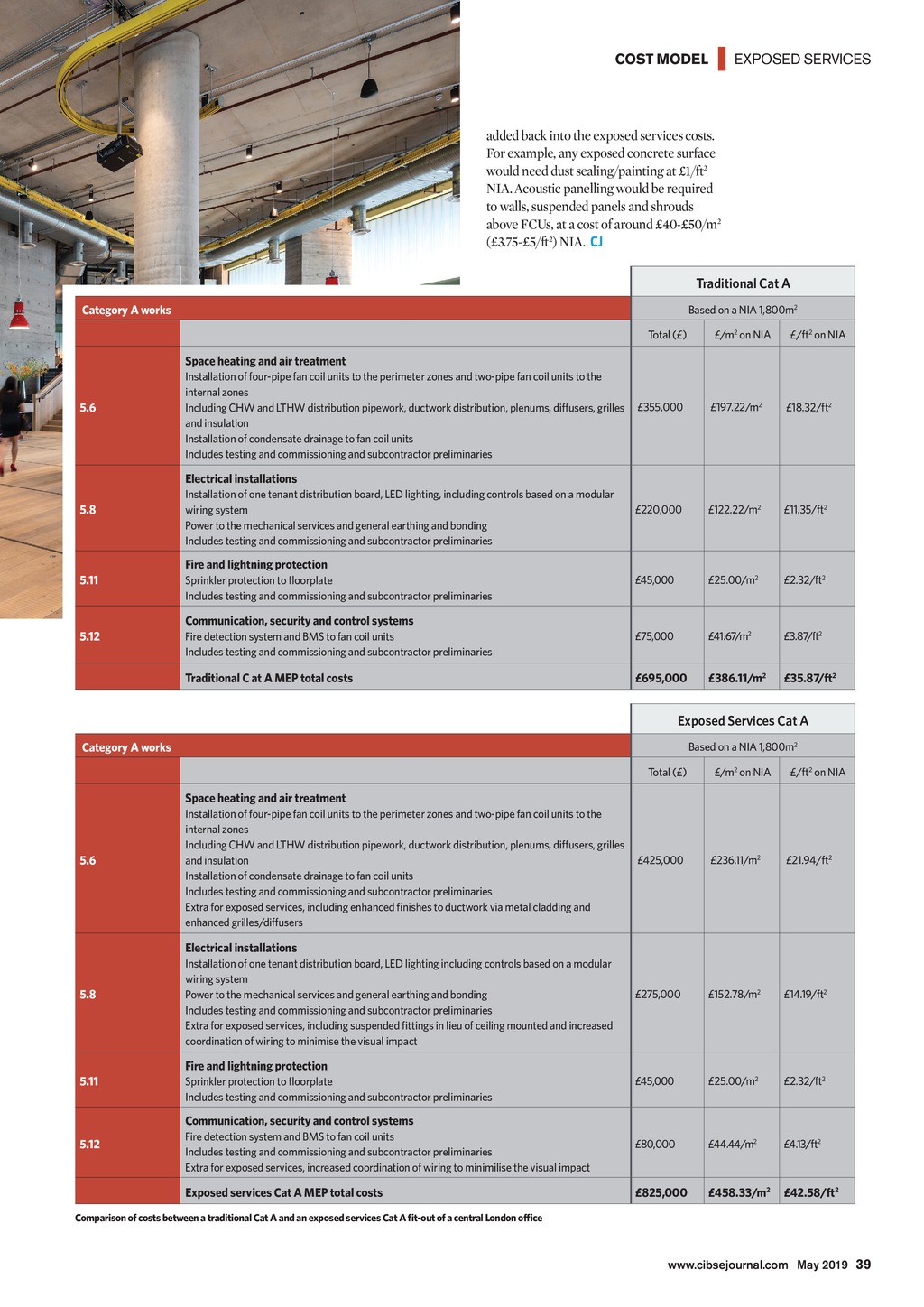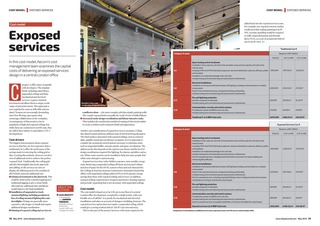




COST MODEL | EXPOSED SERVICES Cost model Exposed services In this cost model, Aecoms cost management team examines the capital costs of delivering an exposed services design in a central London office C ategory A office space is popular with developers. The simplest finish, including raised floors, suspended ceilings and basic mechanical and electrical services, requires minimal investment and allows them to target a wide range of potential tenants. This approach is now regarded by some as inflexible and outdated. Tenants are increasingly demanding more free-flowing, open spaces that encourage collaboration in the workplace. A consequence of this trend is a rise in popularity of high and exposed ceilings, but while these are common in Cat B fit-outs, they are still in their infancy in speculative CAT A developments. Acoustics is also a cost consideration of exposed services a uniform colour a far more complex job than simply painting walls. The casual exposed look is actually the result of a lot of skilled labour Increased onsite design coordination and labour-intensive tasks. This includes the careful and considered routing of electrical conduit to create a uniform and consistent finish and appearance. Another cost consideration of exposed services is acoustics. Ceiling tiles absorb sound and keep ambient noise levels from being disruptive. The hard surfaces associated with exposed ceilings, such as concrete slabs, amplify sound and can distract occupants. So it is important to consider the acoustical control options necessary to minimise noise, such as suspended baffles, acoustic panels, and spray-on solutions. The added cost for this depends on the options you choose and the level of design coordination required (for lighting, fire alarms, sprinklers and so on). White-noise systems can be installed to help, but some people find white noise disruptive and annoying. Exposed services have other hidden expenses, most notably, energy costs. Removing a suspended ceiling will mean an increased volume and area of space for the HVAC system to heat and cool. Research by the Ceilings & Interiors Systems Construction Association found that offices with suspended ceilings achieved 9% to 10.3% greater energy savings than those with exposed ceilings and services. In addition, exposed ceilings required more frequent and stricter cleaning regimes, and periodic repainting that is not necessary with suspended ceilings. Cost drivers The biggest misconception about exposed services is that they are less expensive than a traditional Cat A office fit-out because of the savings made in removing the ceiling grid or tiles. Creating this aesthetic, however, involves a lot of additional work to achieve the perfect exposed look. Traditionally, the ceiling grid and tiles hid unsightly ductwork, pipework and cabling. As the services are now on display, the following need to be considered, all of which represent additional cost: Enhanced treatment to the ductwork. This could be achieved by a metal wrapping over traditional lagging to give a clean finish. Alternatively, additional time and labour would improve the final installation Installation of suspended or trackmounted lighting, including pendants in lieu of ceiling-mounted lighting tiles and downlights. Fittings are generally more expensive, take longer to install and require additional design coordination Painting of exposed ceiling and services in ABOUT THE AUTHORS ALEX GROCOTT is an associate and ANDREW FREEMAN a graduate surveyor at Aecoms London MEP cost management team Cost model The cost model is based on a Cat A fit-out to one floor of a central London office development, occupied by a single tenant, with a net lettable area of 1,800m2. It is purely for mechanical and electrical installations and takes no account of changes to building elements. The exposed services option does not require a suspended ceiling, which would give a saving of about 65/m2 (6/ft2) (net internal area). This is only part of the picture, however, with items required to be 38 May 2019 www.cibsejournal.com CIBSE May19 pp38-39 Cost Model.indd 38 26/04/2019 17:10